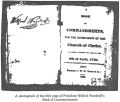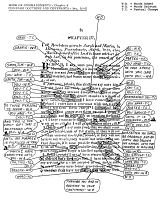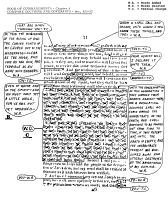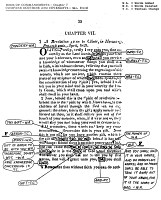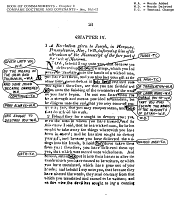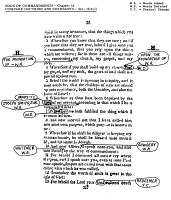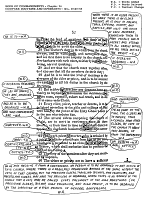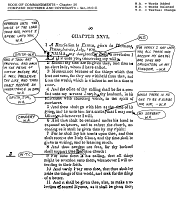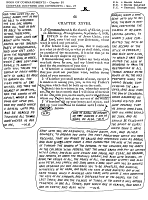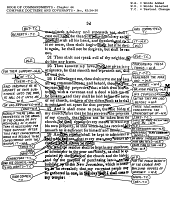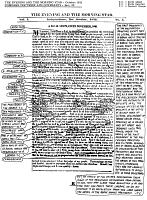Changes In The Revelations
Chapter 3
Mormon Apostle John A. Widtsoe dogmatically stated: "The Doctrine and Covenants is a compilation of the revelations received by Joseph Smith...
"The book itself is a witness for the truth of the Prophet's claims.... Enemies of the Church have rather carefully avoided the discussion of this book. They have been afraid of it" (Joseph Smith—Seeker After Truth, 1951, pp. 251, 254).
Contrary to Apostle Widtsoe's statement, anti-Mormon writers have not been afraid to discuss the Doctrine and Covenants. In fact, they have made some rather serious charges concerning it. The most serious charge, we feel, is that the revelations found in the Doctrine and Covenants have been changed. Some Mormon writers have admitted that changes were made. For instance, the Mormon historian B. H. Roberts admitted that paragraphs were added to the revelations: "...Some of the early revelations first published in the 'Book of Commandments,' in 1833, were revised by the Prophet himself in the way of correcting errors made by the scribes and publishers; and some additional clauses were inserted...and paragraphs added to make the principles or instructions apply to officers not in the Church at the time some of the earlier revelations were given" (History of the Church, vol. 1, p. 173).
In a thesis written at Brigham Young University, John William Fitzgerald stated: "Differences in wording and differences in wording that change the meaning have occurred in certain sections that appeared first in A Book of Commandments published in 1833 and that appeared later in The Doctrine and Covenants published in 1835" ("A Study of the Doctrine and Covenants," Master's thesis, BYU, 1940, p. 329).
In another thesis written at the Brigham Young University, Melvin J. Petersen acknowledged: "Many words were added to the revelations in order to more clearly state what Joseph Smith intended to write.... Many times phrases were added to increase the ability of the reader to get the meaning of the verse" ("A Study of the Nature of and Significance of the Changes in the
38
Revelations as Found in a Comparison of the Book of Commandments and Subsequent Editions of the Doctrine and Covenants," Master's thesis, BYU, 1955, typed copy, p. 147).
On pages 162 and 163 of the same thesis, Mr. Petersen wrote: "...Joseph Smith's language, as found in the revelations credited to him, needed correcting. There were many grammatical errors in the revelations he first published.... Joseph Smith in revising the first published commandments, found many of them needed clarification; therefore he enlarged upon them in order that the meaning might be more easily discerned. Certain omissions were made when unnecessary material was deleted from the revelations; also incidents that were past and of no significance except to a few."
On page 140 of the same thesis, Melvin J. Petersen said: "In the 1835 edition, Section thirty-two, verse three was added in the place of verses five and six. Why such a change? Joseph Smith, while reviewing the revelations, was dissatisfied with the wording of verses five and six in portraying the concept he had received, and therefore he omitted verses five and six of Chapter four and rewrote in their place verse three of the 1835 edition which is identical with Section five, verse nineteen of the present 1921 edition.
"In chapter forty-four of the Book of Commandments (Section forty-two, 1921 edition) the last three verses were left off."
While there have been a few Mormon writers who have been willing to admit that Joseph Smith's revelations have been changed, many have not been that honest. Mormon Apostle John A. Widtsoe said that the revelations "have remained unchanged. There has been no tampering with God's word" (Joseph Smith—Seeker After Truth, p. 119).
Joseph Fielding Smith, tenth president, said that "there was no need for eliminating, changing, or adjusting any part to make it fit; but each new revelation on doctrine and priesthood fitted in its place perfectly to complete the whole structure, as it had been prepared by the Master Builder" (Doctrines of Salvation, vol. 1, p. 170).
To properly understand the changes that have been made in the revelations we must understand the history of the Doctrine and Covenants.
In 1833 the Mormon church published the revelations that had been given to the church by Joseph Smith in a book entitled Book of Commandments. The Mormon writer William E. Berrett explains: "In the latter part of 1831, it was decided by a
39
A photograph of the title page of President Wilford Woodruff''s Book of Commandments.
40
council of Church leaders to compile the revelations concerning the origin of the Church and its organization. The collection was to be called the 'Book of Commandments.'... Joseph Smith received a revelation which was made the preface for the new volume and is now Section 1 of the Book of Doctrine and Covenants. In this preface we read: 'Search these commandments, for they are true and faithful....
"After accepting the collection as scripture it was voted to print 10,000 copies" (The Restored Church, 1956, pp. 138-39).
The church was unable to finish the printing of the Book of Commandments as they had planned because the printing press was destroyed by a mob. In 1835 the revelations were printed again, and the name of the book was changed to the Doctrine and Covenants. New revelations were added to this book and many of the previous revelations were revised. In modern editions of the Doctrine and Covenants we find the following on the page just after the title page:
"Certain parts were issued at Zion, Jackson County, Missouri, in 1833, under the title, Book of Commandments for the Government of the Church of Christ.
"An enlarged compilation was issued at Kirtland, Ohio, in 1835, under the title, Doctrine and Covenants of the Church of the Latter-day Saints."
The exact number of Book of Commandments salvaged before the mob destroyed the printing press is not known. RLDS* Church Historian Richard P. Howard thinks there may have been "several hundred at least":
...the typesetting for the Book of Commandments had progressed through five large galley-proof sheets, each containing thirty-two pages (sixteen printed on either side of each sheet) or a total of 160 pages including the title page.... The typesetting on the Book of Commandments was interrupted,... by the mob depredations committed against the church...
Church members managed to salvage a small number of sets of the five galley sheets already printed and later had them bound and distributed. It is impossible to determine the precise number of copies of the unfinished Book of Commandments distributed in this way, but there must have been several hundred at least, since a number of references to the Book of Commandments were made in the writings of church leaders of that period (Restoration Scriptures, Independence, Mo., 1969, p. 200).
David Whitmer, one of the three witnesses to the Book of Mormon, said that the "revelations were printed in the Book of
*Reorganized Church of Jesus Christ of Latter Day Saints
41
Commandments correctly.... just exactly as they were arranged by Brother Joseph and the others. And when the Book of Commandments was printed, Joseph and the church received it as being printed correctly" (An Address To All Believers In Christ, p. 56).
That the church approved of the Book of Commandments and used it from 1833 until 1835 can be seen from a letter written by the leaders of the Church in Missouri in July, 1834. In this letter it was stated: "It will be seen by reference to the Book of Commandments, page 135, that the Lord has said... 'Let no man break the laws of the land...' " (History of the Church, vol. 2, p. 129).
In the same letter outsiders were advised to "examine the Bible, the Book of Mormon, and the Commandments..." (p. 133).
David Whitmer says that "Joseph and the brethren" received the Book of Commandments "at first as being printed correctly, but they soon decided to print the Doctrine and Covenants" (An Address to Believers in the Book of Mormon, p. 5). The Doctrine and Covenants was printed in the year 1835. Since the same revelations that were published in the Book of Commandments were put into the first edition of the Doctrine and Covenants, one would expect them to read exactly the same as when they were first published. This is not the case, however, and David Whitmer objected to what was done:
Some of the revelations as they now appear in the Book of Doctrine and Covenants have been changed and added to. Some of the changes being of the greatest importance as the meaning is entirely changed on some very important matters; as if the Lord had changed his mind a few years after he give [sic] the revelations, and after having commanded his servants (as they claim) to print them in the "Book of Commandments;" and after giving his servants a revelation, being a preface unto His Book of Commandments, which says: "Behold this is mine authority, and the authority of my servants, and my preface unto the Book of Commandments, which I have given them to publish unto you, oh inhabitants of the earth." Also in this preface, "Behold I am God, and have spoken it; These commandments are of me." "Search these commandments, for they are true and faithful." The revelations were printed in the Book of Commandments correctly! This I know,... Joseph and the church received it as being printed correctly. This I know. But in the winter of 1834 they saw that some of the revelations in the Book of Commandments had to be changed, because the heads of the church had gone too far, and had done things in which they had already gone ahead of some of the former revelations. So the book of "Doctrine and Covenants"
42
was printed in 1835, and some of the revelations changed and added to (Letter written by David Whitmer, published in the Saints' Herald, February 5, 1887).
For many years the Mormon leaders tried to suppress the Book of Commandments. They would not allow us to obtain photocopies of the book from Brigham Young University. Fortunately, however, we were able to obtain a microfilm of the copy at Yale University and had the Book of Commandments printed by photo-offset. Even though the newspapers in Salt Lake City would not allow us to advertise this book we were able to sell all of the copies in a short time.
In order to show some of the important changes that were made in the revelations we obtained photographs of the original Book of Commandments. We have compared these pages with the revelations as published in the 1966 printing of the Doctrine and Covenants and have marked the changes on the photographs. Therefore, in the pages which follow the text is an exact photographic reproduction of the original pages of the Book of Commandments, and the handwriting shows the changes that would have to be made in the text to bring it into conformity with the 1966 printing of the Doctrine and Covenants. Although there have been many changes in the chapter headings, we have not bothered to mark them. Since we are very limited on space in this study we have selected only the pages which contain the most important changes. The reader will notice that we have assigned a letter to some of the changes that we want to discuss later in the study.
The Book of Commandments only had short chapters which consisted of 65 of Joseph's revelations. However, it can be shown that the changes made in these revelations did not constitute all of the changes made in the Doctrine and Covenants. Section 68 of the Doctrines and Covenants was not printed in the Book of Commandments, but it was printed in The Evening and The Morning Star. When it was reprinted in the Doctrine and Covenants it was changed. Commenting on that particular revelation in their book The Book of Commandments Controversy Reviewed (p. 81), Clarence and Angela Wheaton state that "323 words were added and 21 left out." We have included a photograph of this revelation as it was first printed in The Evening and The Morning Star in this study. Below is a key to abbreviations for the study which follows.
Abbreviations we use are: W.A., words added; W.D., words deleted; T.C., textual change.
43
Book of Commandments—Chapter 4
Compare Doctrine and Covenants—Sec. 5:1-11
[W.A., words added; W.D., words deleted; T.C., textual change.]
44
Important Changes
As we indicated earlier, we have placed letters by some of the changes which we wish to discuss.
CHANGE A (see page 44). This is certainly one of the most significant changes in the Doctrine and Covenants. David Whitmer, one of the three witnesses to the Book of Mormon, gave this interesting information:
After the translation of the Book of Mormon was finished, early in the spring of 1830, before April 6th, Joseph gave the stone to Oliver Cowdery and told me as well as the rest that he was through with it, and he did not use the stone anymore. He said he was through the work God had given him the gift to perform, except to preach the gospel. He told us that we would all have to depend on the Holy Ghost hereafter to be guided into truth and obtain the will of the Lord (An Address To All Believers in Christ, p. 32).
The fact that Joseph Smith was not planning on doing any other work besides the Book of Mormon is verified by the revelation given in March of 1829. This revelation was printed in the Book of Commandments as chapter 4. Verse 2 reads as follows: "...and he has a gift to translate the book, and I have commanded him that he shall pretend to no other gift, for I will grant him no other gift."
By the year 1835, when this revelation was reprinted in the Doctrine and Covenants, Joseph Smith had pretended to at least one other gift besides that of translating the Book of Mormon. He had pretended to the gift of correcting the Bible (his so-called Inspired Version), and a short time after this he brought forth the Book of Abraham. Certainly this revelation commanding Joseph Smith to pretend to no other gift but to translate the Book of Mormon could not remain in its original form. The church had decided to go beyond the Book of Mormon and accept Joseph Smith's other writings as Scripture. This change in church policy necessitated a change in the revelation. Therefore, it was changed to read as follows: "And you have a gift to translate the plates; and this is the first gift that I bestowed upon you; and I commanded that you should pretend to no other gift, until my purpose is fulfilled in this; for I will grant unto you no other gift until it is finished" (Doctrine and Covenants, 5:4).
The basic meaning of this revelation was changed by these insertions, making it appear that the Lord would grant Joseph other gifts besides that of translating the Book of Mormon. David Whitmer observed: "The way the revelation has been changed, twenty-two words being added to it, it would appear that God had broken His word after giving His word in plainness; commanding
45
Book of Commandments—Chapter 4
Compare Doctrine and Covenants—Sec. 5:11-22
[W.A., words added; W.D., words deleted; T.C., textual change.]
46
Brother Joseph to pretend to no other gift but to translate the Book of Mormon, and then the Lord had changed and concluded to grant Joseph the gift of a Seer to the Church....
"May God have mercy on the heads of the church for their transgression is my prayer" (An Address To All Believers in Christ, pp. 57-58).
CHANGE B (see page 46). Notice that the words "you must wait yet a little while, for ye are not yet ordained" have been added to this revelation. This revelation was supposed to have been given in March of 1829. Some Mormon writers have claimed that God has a right to add to His word after it is given. But, we ask, why would the Lord wait more than five years to give them this information? What good would it do to give them this information years later? In order for a warning to do any good it has to be given right at the time.
Many of the changes in the revelations appear to be equivalent to locking the barn door after the horse has gotten out.
CHANGE C (see page 46). Notice that 154 words have been deleted from verses 5 and 6 of this revelation. Melvin J. Petersen, a Mormon apologist, stated: "Joseph Smith... was dissatisfied with the wording of verses five and six in portraying the concept he had received, and therefore he omitted verses five and six of Chapter four and rewrote in their place verse three of the 1835 edition..." ("A Study of the Nature of and the Significance of the Changes in the Revelations..." typed copy, p. 140). Mr. Petersen seems to feel that Joseph Smith had a perfect right to do this. Although we agree that Joseph Smith had a right to revise his own writings, we do not feel that he had a right to revise the revelations which he claimed to be the words of God. In the very first revelation that was published in the Book of Commandments we read:
Behold, this is mine authority, and the authority of my servants, and my Preface unto the Book of my Commandments,...
Search these commandments, for they are true and faithful, and the prophecies and promises which are in them, shall all be fulfilled. What I the Lord have spoken, I have spoken, and I excuse not myself, and though the heavens and the earth pass away, my word shall not pass away... (Book of Commandments, 1:2, 7).
If these were really revelations from God, Joseph Smith could not revise them without discrediting the previous declaration.
CHANGE D (see page 48). This revelation is supposed to contain a translation of a parchment written by the apostle John. Mormons claim Smith translated this parchment by means of the Urim and Thummim. When this revelation was published in the
47
Book of Commandments—Chapter 6
Compare Doctrine and Covenants—Sec. 7:1-8
[W.A., words added; W.D., words deleted; T.C., textual change.]
48
Book of Commandments in 1833, it contained 143 words, but when it was reprinted in the Doctrine and Covenants in 1835, it contained 252 words. Thus we see that 109 words have been added.
Mormon writers are unable to explain why Joseph Smith changed this revelation. Melvin J. Petersen admitted that,
When the 1835 edition of the Doctrine and Covenants was published this revelation had many additions and a few changes.... The additional words and sentences reveal more concerning John and his ministry. How Joseph Smith had this information revealed to him, by means of the Urim and Thummim, is not clear. ...What part revelation played in receiving this information concerning John is not known, nor is it known as to how the translation was enacted. We do know that additions and changes were made by Joseph Smith....
Joseph Smith left nothing in his writings to indicate why he added to this translated version... and so any plausible answers will be merely conjecture ("A Study of the Nature of and the Significance of the Changes in the Revelations" typed copy pp. 154-55).
Actually, there are only three logical explanations as to why this revelation does not read the same in the Doctrine and Covenants as it did in the Book of Commandments. First, before reprinting this revelation in the Doctrine and Covenants, Joseph Smith may have decided to falsely attribute words to the apostle John that he did not utter. This explanation would mean that Joseph Smith was guilty of deception.
Second, before the revelation was reprinted, the Lord may have shown Joseph Smith that he had not translated the parchment correctly with the Urim and Thummim and that he must add in 109 words to make it correct. This explanation would cast serious doubt upon Joseph Smith's ability as a translator. Any individual who left out 109 words in the translation of such a short document would be considered a very poor translator!
Third, Joseph Smith may have received the full text of the revelation to begin with but suppressed part of it when the Book of Commandments was printed. Melvin J. Petersen states: "Doctor Sidney B. Sperry,... has suggested that it is possible that Joseph Smith edited the translation in its first published form and then later wrote down the complete translation as it is found in our present text. Whether this suggested answer be right or wrong cannot be determined until further evidence is brought to light upon the problem" (p. 155).
This explanation would also make Joseph Smith irresponsible, to say the least, because he did not put in "the little dots
49
Book of Commandments—Chapter 7
Compare Doctrine and Covenants—Sec. 8:1-10
[W.A., words added; W.D., words deleted; T.C., textual change.]
50
Book of Commandments—Chapter 9
Compare Doctrine and Covenants—Sec. 10:1-12
[W.A., words added; W.D., words deleted; T.C., textual change.]
51
which indicate that one is making deletions" (a failure for which Mormons have faulted anti-Mormon writers). Furthermore there was no real reason to suppress 109 words from the revelation. This revelation is printed on page 18 of the Book of Commandments, and a careful examination of this page reveals that part of the page has been left blank and that there was enough room to include these words. Space-wise there would have been no reason to suppress part of the revelation. More important, in Mormonism—Shadow or Reality? (p. 28), we have reproduced a photograph of a copy of this revelation in the handwriting of Joseph Smith's scribe Frederick G. Williams. This photograph proves beyond all doubt that the text of the revelation now published by the Mormon church in the Doctrine and Covenants has been doctored, for the manuscript agrees with the Book of Commandments.
CHANGES E and F (pp. 48, 50). The first item relates to the priesthood and the second concerns one of the most important changes in the Doctrine and Covenants, both of which we will discuss at a more appropriate place.
CHANGE G (p. 51). The reader will notice that this revelation speaks of the translation of the Book of Mormon. While the first printing of the Book of Commandments said nothing about the name of the instrument used in the translation of the Book of Mormon, in the Doctrine and Covenants the following clause has been interpolated: "By the means of the Urim and Thummim." This is obviously an attempt to tie into the "Urim and Thummim" mentioned in the Bible (see Exod. 28:30). This must have been an afterthought, for the Book of Mormon never uses the words "Urim and Thummim." In a document written in the early 1830's Joseph Smith did not use the words "Urim and Thummim," but instead he stated: "...the Lord had prepared spectacles for to read the Book..." ("An Analysis of the Accounts Relating Joseph Smith's Early Visions," Master's thesis, Brigham Young University, 1965, p. 131).
CHANGE H (p. 53). David Whitmer made the following pointed comment about this change:
The next important change I will speak of, is made in a revelation which was given to Brothers Joseph Smith, Oliver Cowdery, and myself in Fayette, New York, June, 1829.... In the Book of Commandments it reads thus:
"Behold I give unto you a commandment, that you rely upon the things which are written; for in them are all things written, concerning my church, my gospel, and my rock. Wherefore if you shall build up my church, and my gospel, and my rock, the gates of hell shall not prevail against you."
52
Book of Commandments—Chapter 15
Compare Doctrine and Covenants—Sec. 18:2-11
[W.A., words added; W.D., words deleted; T.C., textual change.]
53
Book of Commandments—Chapter 24
Compare Doctrine and Covenants—Sec. 20:49-68
[W.A., words added; W.D., words deleted; T.C., textual change.]
54
But in the Book of Doctrine and Covenants it has been changed and reads thus: "Behold I give unto you a commandment, that you rely upon the things which are written; for in them are all things written, concerning 'the foundation of' my church, my gospel, and my rock; wherefore, if you shall build up my church 'upon the foundation of' my gospel and my rock, the gates of hell shall not prevail against you."
The change in this revelation is of great importance; the word "them" refers to the plates—the Book of Mormon: We were commanded to rely upon it in building up the church; that is, in establishing the doctrine, the order of offices, etc. "FOR IN THEM ARE ALL THINGS WRITTEN CONCERNING MY CHURCH, my gospel, and my rock." But this revelation has been changed by man to mean as follows: That therein is not all things written concerning the church, but only all things concerning "the foundation of" the church—or the beginning of the church: that you must build up the church, beginning according to the written word, and add new offices, new ordinances, and new doctrines as I (the Lord) reveal them to you from year to year:... I want to repeat that I was present when Brother Joseph received this revelation through the stone:... I know of a surety that it was changed when printed in the Doctrine and Covenants....
These changes were made by the leaders of the church, who had drifted into error and spiritual blindness. Through the influence of Sydney Rigdon, Brother Joseph was led on and on into receiving revelations every year, to establish offices and doctrines which are not even mentioned in the teachings of Christ in the written word. In a few years they had gone away ahead of the written word, so that they had to change these revelations, as you will understand when I have finished (An Address To All Believers In Christ, pp. 58-59).
CHANGE I (p. 54). Notice that 97 words have been added. David Whitmer made this statement concerning this interpolation:
The next change of importance is in a revelation given in Fayette, New York, June, 1830....
The heading over it in the Book of Commandments is as follows: "The Articles and Covenants of the Church of Christ, given in Fayette, New York, June, 1830." Two paragraphs have been added to it, having been thrust into the middle of it. Paragraphs 16 and 17 is the part added, [vv. 65-67 in current Utah ed.] which part speaks of high priests and other high offices that the church never knew of until almost two years after its beginning: As if God had made a mistake in the first organization of the church, and left out these high important offices which are all above an elder; and as if God had made a mistake and left these high offices out of that revelation when it was first given. Oh the weakness and blindness of man! (An Address To All Believers In Christ, p. 59).
55
Book of Commandments—Chapter 26
Compare Doctrine and Covenants—Sec. 25:1-11
[W.A., words added; W.D., words deleted; T.C., textual change.]
56
Book of Commandments—Chapter 28
Compare Doctrine and Covenants—Sec. 27
[W.A., words added; W.D., words deleted; T.C., textual change.]
57
Book of Commandments—Chapter 44
Compare Doctrine and Covenants—Sec. 42:24-36
[W.A., words added; W.D., words deleted; T.C., textual change.]
58
CHANGE J (p. 56). Notice that in this revelation Emma Smith, Joseph's wife, is told that she would be supported "from" the church, but in the Doctrine and Covenants it has been changed to make it appear that Joseph Smith would support her "in" the church. Mormon leaders have condemned other churches for having a paid ministry. This change seems to have been made to cover up the fact that Joseph Smith was receiving money from the church.
CHANGE K (p. 57). Notice that over 400 words have been added to this revelation. Part of the interpolation concerns the visitation of Peter, James, and John to Joseph Smith. The Mormon leaders claim that they restored the Melchizedek priesthood. David Whitmer, however, said that the Melchizedek priesthood came into the church by a process of evolution rather than by revelation. The fact that these words concerning the visitation of Peter, James, and John had to be added to the revelation tends to confirm David Whitmer's charge. We will have more to say about this in the chapter on priesthood.
CHANGE L (p. 58). In the Book of Commandments the Mormons were told to "consecrate all" their properties to the church, but in the Doctrine and Covenants they were told only to "consecrate of" their properties.
The Mormons were accused of attempting "to establish communism." The change in the revelation was evidently made to cover up the truth concerning this matter. Fawn Brodie wrote that
Joseph Smith set up an economic order in his church which followed with a certain fidelity the life history of the typical communistic society of his time.... Joseph issued a revelation setting up the United Order of Enoch.... Private property became church property, and private profit a community spoil....
Whatever surplus the steward exacted from the land, or whatever profit the mechanic derived from his shop, was contributed to the church storehouse and treasury, the convert keeping only what was "needful for the support and comfort" of himself and family. The spirit of true Marxian communism—"from each according to his ability, to each according to his need"—was implicit in the whole system (No Man Knows My History, 1957, p. 106).
Sidney Rigdon may have been the one who influenced Joseph Smith to start the United Order. Fawn Brodie mentions that "Joseph's enthusiasm for the United Order was always tempered by the fact that it was Rigdon's conception" (Ibid., p. 108). Joseph Smith finally decided that the United Order would not work out,
59
Book of Commandments—Chapter 44
Compare Doctrine and Covenants—Sec. 42:62-73
[W.A., words added; W.D., words deleted; T.C., textual change.]
60
The Evening and the Morning Star—October 1832
Compare Doctrine and Covenants—Sec. 68
[W.A., words added; W.D., words deleted; T.C., textual change.]
61
and therefore it became necessary to change the revelation to cover up the original plan.
CHANGES M, N, O, P and Q. These changes are concerning Priesthood, a subject we shall deal with in a later chapter.
Besides the thousands of words which were added, deleted or changed in the revelations after they were published in the Book of Commandments and other early publications, one whole section on marriage has been removed. Also, the Lectures on Faith, which comprised seventy pages of the 1835 edition of the Doctrine and Covenants, have been completely removed from later editions. Mormon writers admit that the section on marriage and the Lectures of Faith have been removed, but very few of them will admit that there have been actual meaning changes in the revelations which are still printed in the Doctrine and Covenants.
All of these alterations have been made within just a little over 140 years. Imagine what would have happened to the Bible if the churches that preserved it had altered it at the same rate the Mormons have altered the Doctrine and Covenants. We would be lucky to have anything the way it was originally written!
Important Change in Newly-Accepted Revelation
On April 3, 1976, the Church Section of the Deseret News reported: "Two revelations received by former Presidents of the Church, were accepted as scripture Saturday afternoon, April 3, by vote of Church membership....
"The new scriptures, which will be arranged in verses as part of the Pearl of Great Price, include the account of the Prophet Joseph Smith's vision of the Celestial Kingdom received Jan. 21, 1836...."
After these two revelations were canonized by the Mormon church, Michael Marquardt, a student of Mormon history, discovered that the one concerning Joseph Smith's vision of the Celestial Kingdom had been altered. Mr. Marquardt found that this revelation was recorded in Joseph Smith's own diary under the date of January 21, 1836. In Joseph Smith's diary the revelation read as follows:
"The heavens were opened upon us and I beheld the celestial Kingdom of God,... I saw father Adam, and Abraham and Michael and my father and mother, my brother Alvin (Joseph Smith's Diary, January 21, 1836, p. 136; original in LDS historical department).
When the Mormon leaders printed this revelation they deleted the words "and Michael" without any indication. It reads as follows in the Deseret News, Church Section, April 3, 1976: "The
62
heavens were opened upon us and I beheld the celestial kingdom of God,... I saw Father Adam and Abraham, and my father and my mother, my brother, Alvin,..."
At first glance the deletion of the words "and Michael" does not appear too important. In Mormon theology, however, a serious problem is created by the statement "I saw father Adam, and Abraham and Michael...." According to Joseph Smith's other revelations, Adam is Michael. In the Doctrine and Covenants 107:54 we read: "And the Lord appeared unto them, and they rose up and blessed Adam, and called him Michael, the prince, the archangel." In 27:11 we read: "And also with Michael, or Adam, the father of all, the prince of all, the ancient of days." Thus it is clear that if Adam is Michael, Joseph Smith could not have seen "Adam, and Abraham and Michael." The Mormon leaders must have been aware that this would create a problem in Mormon theology, and therefore they deleted the words "and Michael" from the revelation.
This change was apparently made sometime while the church was under Brigham Young's leadership. The fact that the change was made after Joseph Smith's death is evident from Mr. Marquardt's research. He found that the revelation was copied into the handwritten manuscript of the History of the Church (book B-1, p. 695), with the words "and Michael" still included. Mr. Marquardt also found that the words were in the duplicate copy of the "Manuscript History," (book B-2, p. 618). This is significant because the Mormon leaders did not even start the duplicate copy until almost a year after Joseph Smith's death (see Brigham Young University Studies, Summer 1971, p. 469). This would mean that the change had to have been made after Smith's death. By the time the revelation was published in the Deseret News, September 4, 1852, the words "and Michael" had been deleted. Thus it appears that the change took place sometime between 1845 and 1852 and that current Mormon leaders have canonized a falsified revelation.
Mormon leaders have been very free in accusing others of making changes. Apostle Mark E. Petersen says that "deliberate falsifications and fabrications were perpetrated" in the Bible (As Translated Correctly, 1966, p. 4). On page 27 of the same book, the Apostle Petersen states: "It seems unthinkable to the honest and devout mind that any man or set of men would deliberately change the text of the Word of God to further their own peculiar purposes."
We certainly agree that it would be dishonest to change the
63
"Word of God," but we wonder how the Mormon leaders can justify the changes in Joseph Smith's revelations, since they consider them also to be the "Word of God." Bruce R. McConkie stated: "As now constituted the Doctrine and Covenants contains 136 sections.... Most of these sections came to Joseph Smith by direct revelation, the recorded words being those of the Lord Jesus Christ himself" (Mormon Doctrine, 1966, p. 206).
Now, certainly after we see the charges made against the Bible by the Mormon leaders, we would expect to find Mormon writings to be completely free of changes or alterations of any kind. Of all Mormon writings we would expect the Doctrine and Covenants to be the most pure and free from revision. The reason for this is that the Doctrine and Covenants purports to be the revelations given directly from God to Joseph Smith—not just a translation. We would expect these revelations to be completely free from alteration. Yet, upon careful examination, we find thousands of words added, deleted or changed. How can the Mormon leaders explain this?
Many Mormons deny that the revelations were changed. Those who have done more study admit that changes were made but try to justify them by saying that God has a right to change His word. Melvin J. Petersen wrote:
Once a man has been recognized and accepted as a prophet and favored with communications from God, his great responsibility is to make sure, inasmuch as he has power to do so, that those to whom the communications are directed, understand what God has revealed for them. The power is his to revise, correct, omit, or change any of his writings in order that he might manifest more clearly what God revealed through him....
A prophet cannot be justly criticized when he rewrites the commandments he received from God, for he is only doing that which is part of his role as a prophet ("A Study of the Nature of and the Significance of the Changes in the Revelations," pp. 164-165)
We cannot understand how Mr. Petersen can reason in this way. David Whitmer pointed out the absurdity of such an idea when he wrote:
Is it possible that the minds of men can be so blinded as to believe that God would give these revelations—command them to print them in His Book of Commandments—and then afterwards command them to change and add to them some words which change the meaning entirely? As if God had changed his mind entirely after giving his word? Is it possible that a man who pretends to any spirituality would believe that God would work in any such manner? (Saints' Herald, February 5,1887).
64
In the "Explanatory Introduction" to the Doctrine and Covenants (p. v) we find what purports to be the testimony of the Twelve Apostles to the Doctrine and Covenants. Among the names signed on this purported document we find that of Apostle William E. McLellin. In later years, however, McLellin claimed that this "testimony" was a "base forgery." McLellin also had a great deal to say about the changes in the revelations. The Salt Lake Tribune for October 6, 1875, printed the following statement regarding McLellin: "His faith was first shaken by the changes made in the revelations. He had been careful to keep copies of the originals, presented proof that all the early revelations were changed three times, and considerably amended before they appeared in their present form."
William E. McLellin was reported as saying:
In 1835 in Kirtland another committee was appointed to fix up the revelations for print again.... I was often in Joseph's office, and know positively that some of the revelations were so altered, mutilated and changed that a good scholar would scarcely know them. In one revelation I counted 20 alterations! Hence, who can depend upon them? I cannot. I will not.... All your trouble arises from your taking that mutilated and altered Doctrine and Covenants (Saints' Herald, 17:556, 557, as quoted in Changing of the Revelations, by Daniel Macgregor, p. 6).
Since William E. McLellin was an apostle in the Mormon Church, his statements are certainly important. Even more significant, however, is the fact that David Whitmer, one of the three special witnesses to the Book of Mormon, would write a book in which he criticized Joseph Smith for changing the revelations. He stated that
...when the Book of Doctrine and Covenants was published... a very few of the brethren then knew about most of the important changes that had been put in the Book of Doctrine and Covenants. In time it was generally found out, and the result was that some of the members left the church on account of it.... When it became generally known that these important changes had been made in the Doctrine and Covenants, many of the brethren objected seriously to it, but they did not want to say much for the sake of peace, as it was Brother Joseph and the leaders who did it. The majority of the members—poor weak souls—thought that anything Brother Joseph would do, must be all right; so in their blindness of heart, trusting in an arm of flesh, they looked over it and were led into error... (An Address To All Believers In Christ, by David Whitmer, Richmond, Mo., 1887, p. 61).
On page 49 of the same book, David Whitmer charged:
You have changed the revelations from the way they were first
65
given and as they are to-day in the Book of Commandments, to support the error of Brother Joseph in taking upon himself the office of Seer to the church. You have changed the revelations to support the error of high priests. You have changed the revelations to support the error of a President of the high priesthood, high counselors, etc. You have altered the revelations to support you in going beyond the plain teachings of Christ in the new covenant part of the Book of Mormon.... You who are now living did not change them, but you who strive to defend these things, are as guilty in the sight of God as those who did change them (An Address To All Believers In Christ, p. 49).
66
